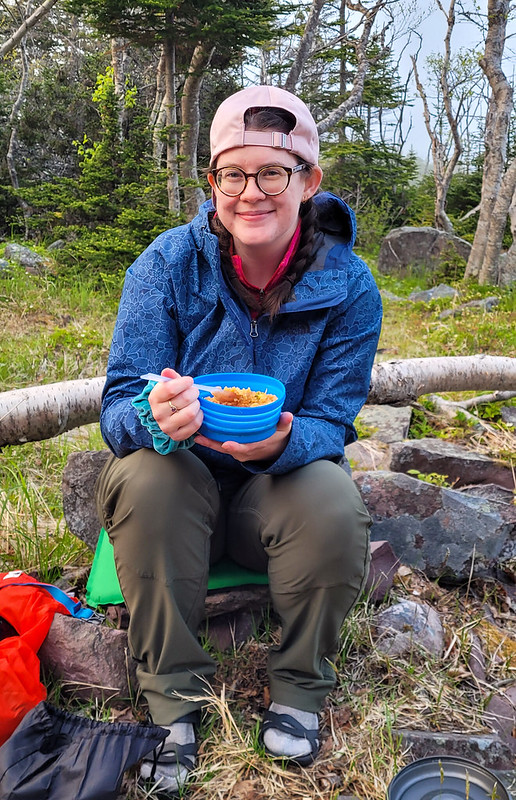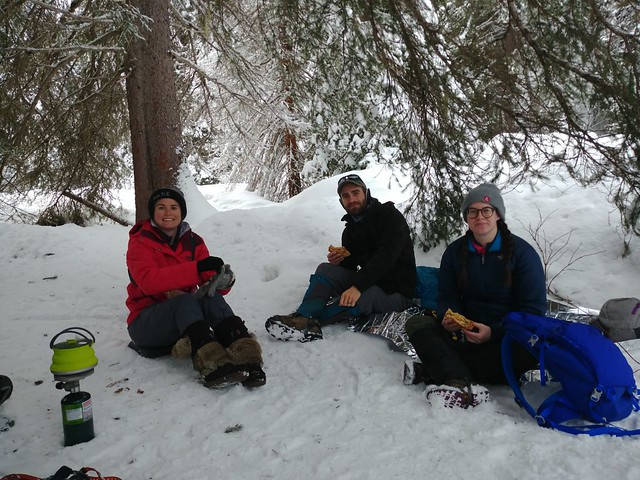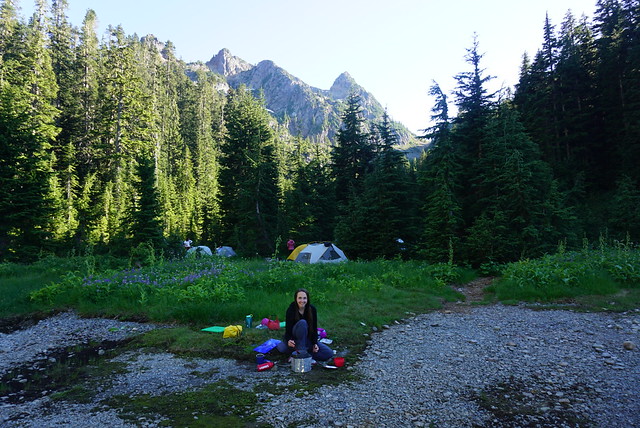Continuing my backcountry meal series, I want to talk about lunch. For the most part, I don’t need to bother with the dehydrator for breakfast, but I find it lightens my pack so much to use it on my lunches and suppers. I’ve developed a two-part post for both of these meals. This week I’m talking exclusively about lunches that require a dehydrator, but next week I’ll cover lunch ideas that don’t need one! If you’re new to dehydrating, see my introduction post.
Cold soaking is a bit of a new trend in backpacking, so for those who have never heard of it, it’s basically choosing meals that can be re-hydrated over the span of a few hours with just cold water, no cooking involved. While cold soaking requires the same amount of work as hot meals when it comes to the prep, the practice of cold soaking is something that has completely changed my backpacking experience.
I’ve never done hot meals for lunch. I don’t like the extra time and fuel required to cook a meal in the middle of the day and hate being stuck with dirty dishes, so before I discovered cold soaking, I always brought ready to eat items for lunch. While this makes for an easy lunch, it’s a lot heavier to carry a salami stick for multiple days and food safety can get dicey when it’s hot.
Any dehydrated food can be made edible again by soaking it for a few hours in cold water, though many are not as tasty to eat cold as they are hot. By focusing on foods that are still yummy cold, you can add water to your sealable lunch container at breakfast and by lunchtime, all you have to do is take out your fork and start eating. All my cold soak lunches involve dehydrating, but are built around things I don’t mind eating cold. Here’s some of my favourites:
1. Pasta and Soybean Salad
Lots of salads are meant to be eaten cold, so that’s a great place to start. I originally found this recipe in a Betty Crocker cookbook and made it regularly for BBQ’s. Turns out, if you leave the dressing off, it works great for cold soaking! I don’t have a specific recipe, but google any pasta salad that sounds good to you and leave off the dressing. In mine, I use macaroni and then add diced bell pepper, grated carrot, and diced tomato, but you could add any vegetable you like (avoid lettuce). Then I add chickpeas and edamame for protein. Once done, I pop the entire thing in the dehydrator for 8 hours and once I’ve re-hydrate it in the field, I add freeze dried cheese (such as whisps) and a little bit of salad dressing (zesty italian is my preference). It’s a bit annoying to carry the salad dressing, but the rest of the meal is so light.
2. Taco Salad
Taco Salad is a newer recipe for me, but I think it’s my favourite cold soak lunch to date. Most of my hiking companions are vegetarian or have dairy sensitivities, so all of my meals are vegetarian (and often vegan) except for this one (though you can easily sub soymeat!). Similar to the pasta salad, I don’t have a specific recipe, I just cook some ground beef (lean) in taco seasoning and add whatever I want to it. Usually that includes diced onion, tomato, and pepper, as well as salsa, corn, grated carrot and sometimes spinach. My only tips are to skip avocado (too fatty to dehydrate) and use grated carrot instead of diced as it re-hydrates much easier! Once satisfied, I pop the whole thing in my dehydrator for 8 hours and then after I re-hydrate it, I add crunched up tortilla chips. Carolyn actually brings full taco shells with her, but I like the chips because it doesn’t matter if they get smashed in your bag.
3. Peanut Butter Pasta Salad or Coleslaw
Since most of my recipes are vegetarian, finding a good source of protein is always important, as well as something that dehydrates well (if you’re new to dehydrating, avoid chicken). I started following HealthyGirlKitchen on instagram and she shares a lot of recipes for healthy salads and pastas. She shared a few that are made with a soy peanut butter dressing that translate great to the backcountry! A lot of dressings involve oil, which doesn’t dehydrate, so I decided to try out the PB dressing, and it dehydrates really well. I ended up making one PB pasta using macaroni, with soybean and chickpeas for protein, and then a coleslaw using a pre-shredded cabbage mix (make sure no lettuce). Both are a variation on this rainbow pasta recipe, where I add the veggies I like. The coleslaw isn’t as filling as the pasta, so you could also add some rice to it. Once you’re happy with the taste, throw the whole thing in the dehydrator for 8 hours! My only recommendation is that the peanut butter flavour isn’t as strong once dehydrated, so I also add some PB2 powder to the dried mix for extra flavour.
4. Mexican Rice
To be honest, this is pretty similar to my taco salad recipe, with rice instead of tortilla chips, but the end result seems different somehow. The key change is that I use black beans instead of ground beef, otherwise I use all the same veggies and a salsa or tomato sauce for the base. If you want to save some time dehydrating, you can just fry all the veggies to make the sauce and leave the rice out. Instant rice will re-hydrate with cold water, so it’s not necessary to cook it and then dehydrate it again, though this is my preference because then the rice imbibes the flavour better. Note that only instant rice can be rehydrated with cold water – normal rice will need to be cooked with hot water and can’t be used for cold soaking. Either way, dehydrate with or without cooked rice for 8 hours. I usually add whisps cheese to this one in the field. It’s also great heated for supper, but I don’t mind eating it cold for lunch.
5. Quinoa Salad
There are lots of quinoa and couscous salad recipes that also translate well to dehydrating. One that I’ve adapted is a Mediterranean salad – I use chickpeas for my protein and then add a bunch of veggies (bell pepper, tomato, red onion, tomato, carrot, olives, cucumber, etc). Here’s a recipe you can use as a base – again, most of these recipes call for olive oil, but this one has a lemon oregano base, so I add both of those ingredients to the salad and leave out the olive oil. It’s a bit drier than I’d like at home, but it hits the spot well enough in the backcountry, though it’s not a big deal to bring a small thing of oil if you really want it! Sometimes I’ll add a bit of maple syrup to give it some extra flavour, and take craisins and nuts/seeds with me to add to the final product (don’t dehydrate or soak the craisins and nuts, just add right before you eat).
6. Pasta Bolognese
This recipe is basically your classic tomato based spaghetti, but with a smaller pasta like macaroni or penne, which is easier to dehydrate. I like to use soymeat as the protein for this meal, but you could also use ground beef or beans. I fry up the soymeat with tomato sauce and add onion, pepper, and grated carrot. If you want to cold soak it, you have to also cook and dehydrate the pasta, but if you plan to eat it hot, you could just dehydrate the sauce and cook the pasta at camp. I like to add cheese whisps to this one for more flavour!


